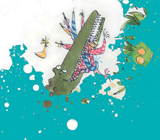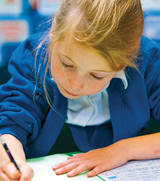Pass round the storyteller's cloak and let children retell their own dastardly versions of The Enormous Crocodile on Roald Dahl Day...
Prior to starting this unit, you need to do a little preparation so that the children are engaged from the beginning. You will need a small suitcase or attaché case. In the case, place a copy of The Enormous Crocodile by Roald Dahl, a collection of animals: crocodile, hippopotamus, elephant, monkey, exotic bird (these can be soft toys or small-world style toys); and a storyteller’s cloak. You will also need to write a letter along the lines of the one below (a touch of tea staining and a scattering of glitter across the letter would add authenticity):
Dear class,
Your headteacher has asked me to visit your school to tell you some stories on 13th September. The 13th September is Roald Dahl Day because it is the birthday of the World’s Number One Storyteller.
Unfortunately, I can’t come and tell stories because I am at a Storytellers’ Gathering in a land many, many miles away. I beg you to come to my assistance as I hate to let people down.
I have sent you my very special Storyteller’s Suitcase. Use the contents to make your own stories and then tell them at your very own Storytellers’ Gathering on 13th September. Good luck my little Storytellers.
With very best wishes from
Estorie Fabricas
Storyteller extraordinaire
 Arrange for a dramatic delivery of the suitcase to the classroom and, with a suitable sense of awe and wonder, unpack it in front of the children. Talk about the contents as you take them out of the suitcase, keeping the letter until last. Read the letter and ensure that the children understand the task that Estorie Fabricas has set them. Focus on the copy of The Enormous Crocodile and discuss with the children how this could help them to make their own stories. If necessary, suggest that reading the book might give the children some ideas for their own stories.
Arrange for a dramatic delivery of the suitcase to the classroom and, with a suitable sense of awe and wonder, unpack it in front of the children. Talk about the contents as you take them out of the suitcase, keeping the letter until last. Read the letter and ensure that the children understand the task that Estorie Fabricas has set them. Focus on the copy of The Enormous Crocodile and discuss with the children how this could help them to make their own stories. If necessary, suggest that reading the book might give the children some ideas for their own stories.
Read the beginning of the book, up to the point where the Enormous Crocodile crawls out of the river. Discuss with the children what they think his secret plans and clever tricks might be. Continue reading and each time The Enormous Crocodile meets an animal, show the relevant toy to the children. Pause when the Enormous Crocodile comes out of the jungle into the sunshine. Ask the children how they feel about the Enormous Crocodile and his behaviour. Encourage them to support their responses with evidence from the text.
Read Clever Trick Number One up to when Toto and Mary run back to the town. Ask the children why they think that the hippopotamus warned the children about The Enormous Crocodile. What do they think will happen next? Continue reading to the point where the elephant is holding the crocodile up in the air. Ask the children to predict what is going to happen to the crocodile. Read through to the end of the book and discuss the children’s responses to the crocodile’s fate. Do they feel that he deserved it? Do they think that the crocodile’s clever tricks really were clever?
 Remind the children that Estorie Fabricas has asked them to use the contents of the special Storyteller’s Suitcase to help them make their own stories. Return to The Enormous Crocodile and skim through the first part, identifying the order in which the crocodile meets the various animals. Using a large sheet of paper, start to develop a story map that gives a visual representation of the story. Draw the settings in which the crocodile meets each animal and place the relevant toys in their settings. Revisit the rest of the book, adding each clever trick, its setting and the animal that foiled each trick to the story map. Use the story map to talk through the basic storyline of The Enormous Crocodile.
Remind the children that Estorie Fabricas has asked them to use the contents of the special Storyteller’s Suitcase to help them make their own stories. Return to The Enormous Crocodile and skim through the first part, identifying the order in which the crocodile meets the various animals. Using a large sheet of paper, start to develop a story map that gives a visual representation of the story. Draw the settings in which the crocodile meets each animal and place the relevant toys in their settings. Revisit the rest of the book, adding each clever trick, its setting and the animal that foiled each trick to the story map. Use the story map to talk through the basic storyline of The Enormous Crocodile.
Put on the storyteller’s cloak and explain that anyone wearing this item of clothing becomes a storyteller extraordinaire. Return to the story map and talk through the storyline once more. Start to develop it as an oral version, creating memorable patterns by adding repeated words and phrases, actions and time connectives (see ‘It’s the way you tell them’). Encourage the children to join in with the retelling and gradually withdraw, leaving them to do the bulk of it. Encourage the children in their retelling with the reward of wearing the storyteller’s cloak. Once they have mastered the retelling, ask them to create their own version of the story map. They can then use these as the basis for retelling the story to each other, other classes and adults in the school.
Remind the children that their task is to write and then tell stories at the Storytellers’ Gathering. Discuss who the audience at the gathering will be and explore the purpose of their stories, i.e. to entertain the audience. Tell them that because they now know the story of The Enormous Crocodile so well, they can use it as the basis for their stories. Explain that they are not writing a whole book, like Roald Dahl did, but they will produce a much shorter story. You might, at this point, want to receive another letter from Estorie Fabricas in which he gives some guidance on what makes a good story, e.g. the structure, particular language features, use of punctuation. Obviously, you can tweak the letter to reflect the areas of literacy that you want the children to focus on.
Tell the children that you would like them to help you to write a story in which a different animal carries out a clever trick. Involve them in identifying the animal that will be the main character, e.g. a snake; his idea of a clever trick, e.g. to pretend to be a rope swing; and his fate, e.g. to be thrown into a deep, dark lake. As you write the story, draw on some of the language and techniques used by Roald Dahl in The Enormous Crocodile, e.g. ‘Under the coolest, craggiest rock in Africa, a snake lay in the shade’.
Support the children in creating their own versions of the story. Some children may wish to write a longer story so could include more than one clever trick. Once they have written their story, they can create a story map and then turn it into an oral retelling.
As the Storytellers’ Gathering approaches, another letter can be received from Estorie Fabricas containing advice on storytelling (see ‘It’s the way you tell them’). Use this advice to hone the children’s storytelling skills. Build up anticipation about the Storytellers’ Gathering by inviting special guests and producing an illustrated programme. Hold the Storytellers’ Gathering, allowing children to wear the special storyteller’s cloak as they retell their stories. You could publish the children’s stories as an ‘Enormous Anthology’ or produce a CD of the retellings and offer them to guests as a souvenir of the event.
Author Gill Matthews runs workshops on the Writing for Real approach. Further details are available on her website (gillmatthews.co.uk) – just follow the Writing for Real link. Gill is also cofounder of The Professional Literacy Company with Pie Corbett, Stephanie Austwick and Kevin Jeffery (theplc.org.uk).
Use drama to help children get to grips with the book…
To extend children’s understanding of The Enormous Crocodile, provide opportunities for them to respond to the text through a variety of drama activities. Role playing the narrative will raise awareness of the structure of the story. Children can hot seat any of the characters from the story, questioning their motives and actions. This will give an insight into the characters and their roles in the story. Freeze frame some of the more dramatic moments in the story and encourage children to think about how each character is feeling and what they are thinking or saying.
Roald Dahl Day takes place each year on 13th September – the birthday of ‘the world’s no.1 storyteller’ and continues throughout the month. Your school may well be marking the occasion with a dress like a Roald Dahl character day or one of the other marvellous suggestions available from http://www.roalddahl.com Or, how about hosting a Storytellers’ Gathering, where children and adults entertain each other with some ripping yarns?
 Try these storytelling tips…
Try these storytelling tips…
Telling stories in an entertaining and effective way can be challenging. Here are a few ideas to help create successful storytellers in your class.
• Incorporating patterned language helps the teller to remember the story and the listener to appreciate the rhythms of the telling. Patterned language includes repeated words and phrases and repeated events.
• Recognisable story language is also important. As soon as the phrase ‘Once upon a time’ is uttered, any listener knows that he, or she, is about to be told a story and certain expectations are raised.
• Traditionally, storytellers make great use of ‘the rule of three’. Whether it be three events, three characters or phrases containing three words, all are effective tools of the trade.
• Storytellers need to engage their audience. This can be done through the use of artefacts related to the story, percussion instruments to emphasise the arrival of a character or a particularly dramatic moment, gestures, facial expression and body language to add a further layer of meaning.
Top tips for differentiation
Ace-Maths
Boosting children’s self esteem
Ace-Classroom-Support
If your marking doesn’t affect pupil progress - stop it!
Ace-Classroom-Support
Use the bottle-flipping craze to create good school behaviour, not bad
Behaviour Management
